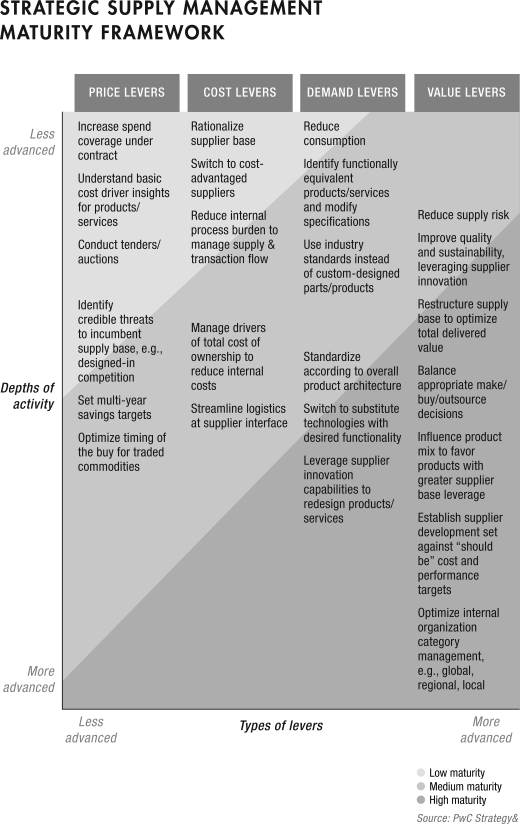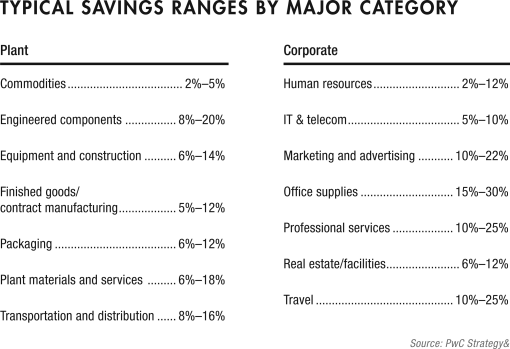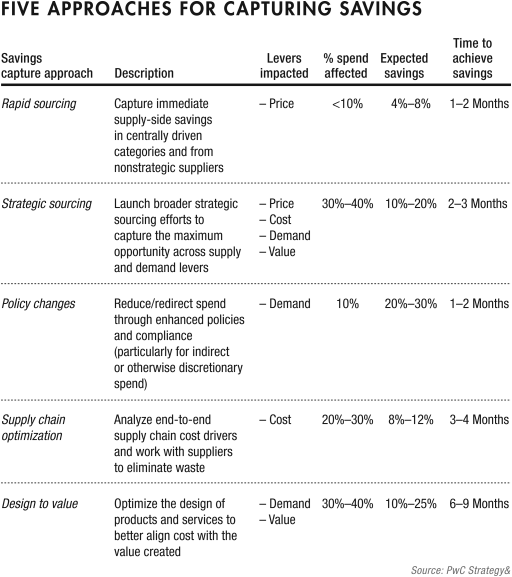12
Strategic Supply Management
Extract More Value from Your Purchases
Strategic supply management drives savings in nonlabor third-party expenditures, which can represent as much as 60 percent of costs at some companies. This fact alone makes strategic supply management an essential lever for any broad-based cost transformation. But it does more than simply reduce nonlabor costs; unlike traditional sourcing methods predominantly focused on price and supplier negotiations, strategic supply management aims to maximize value in procurement activities across the organization. This cross-organizational quest for value puts strategic supply management at the center of sustainable, strategic Fit for Growth transformations.
What Is Strategic Supply Management?
Vast nonlabor expenses are perennial targets for cost-reduction campaigns. Yet many procurement organizations have already consolidated suppliers, centralized purchasing, renegotiated prices, and pursued other supply-side measures to drive down this “spend” (as managers typically refer to a stream of expenditures). Successful as these efforts often are, most of them fall short of delivering all potentially achievable costs savings. The reason is that they are tactical, focused narrowly on competitive price and cost inputs, and overlook other levers and the impact of demand on procurement costs.
Strategic supply management, by contrast, is a comprehensive, holistic approach that addresses all price, cost, demand, and value levers for nonlabor spend, and reaches beyond merely “optimizing the buy” to maximize value in procurement. While price and cost savings usually are easier to achieve, significantly greater upside can be realized through the more complex demand and value levers, which require greater cross-functional collaboration.
Strategic supply management, for example, captures savings opportunities in categories that are often excluded from traditional procurement transformation programs, such as marketing and legal expenses. It's rooted in a deeper understanding of procurement maturity levels and opportunities for value creation in a company's direct and indirect spend.
Procurement maturity is defined by the depth and sophistication of the various levers applied in a spend category (see Figure 12.1 ). Potential savings opportunities can be significant in areas of lower maturity that have relied principally on price and cost levers. Conversely, more-mature categories may have less incremental savings potential.

Direct spend typically encompasses raw materials, packaging, transportation, and other expenditures directly related to producing goods. Most product-based companies have relatively mature procurement practices in these categories, which represent the majority of nonlabor spend. Direct spend is typically centralized under a sophisticated procurement organization that uses advanced techniques to reduce supplier costs and control internal demand.
Still, there's more value to be captured in direct spend categories. Strategic supply management expands on price-based measures by challenging product and portfolio decisions that drive up costs without creating distinct value in the marketplace. Product supply costs reflect an array of choices about materials, ingredients, features, the number of SKUs produced, and other factors that don't always matter very much to customers. Winnowing product lines, substituting less costly materials, or redesigning products through a “design-to-value” lens can reduce procurement costs without jeopardizing sales.
Potential savings (as a percentage of the spend base) are even greater in indirect spend—a surprisingly large percentage of procurement outlays that often elude cost-transformation efforts. Indirect spend represents the lion's share of nonlabor expenses at service companies, and up to half at some manufacturers. Most indirect spend appears in SG&A expenses for categories such as professional services, travel, IT, temporary office labor, overnight shipping, marketing, advertising, and office supplies. COGS also includes some indirect spend, in categories such as MRO, service and supplies, and temporary factory labor.
It's not hard to understand why most companies have made little progress optimizing indirect spend. Control of indirect categories—except for basics like office supplies and travel—often resides outside procurement's sphere of influence, scattered among various functional groups that may not have adopted effective policies or cost controls. This makes it difficult to clearly see the nature of spend in indirect categories, which is recorded piecemeal in departmental budgets across the company. Imposing spend discipline in these categories poses an even greater challenge. Indirect purchasing decisions can be fragmented among numerous individuals, undermining transparency and accountability for what is bought and from whom. Left to their own devices, these decision makers often ignore company procurement policies such as preferred supplier designations and spend thresholds for competitive bids.
A well-executed strategic supply management program encompassing direct and indirect categories can reduce total external spend by 10 percent to 15 percent, often within six to nine months. (See Figure 12.2 .) And by expanding the focus of procurement from price to value, it establishes the foundation for a more strategic approach to cost management across the company.

Successful strategic supply management initiatives maximize savings by using the full suite of price, cost, demand, and value levers in every category. The savings generated by each lever varies among categories.
In addition to its own direct benefits, strategic supply management can enhance the impact of other cost levers. For example, the principles of strategic supply management also apply to outsourcing, which is, after all, a form of sourcing. However, the application of various levers in a broad cost transformation program should be coordinated to avoid unnecessary or redundant effort. There's little sense in optimizing sourcing for a function slated for elimination under a zero-basing initiative.
When Should a Company Use Strategic Supply Management?
Since strategic supply management can produce significant savings in a category of spending that encompasses a large portion of total costs, it is an essential lever for any comprehensive cost-transformation program based on Fit for Growth principles. In addition, it's a good place to start, since nonlabor cost savings are far less sensitive than headcount reductions and often can be implemented faster. Strategic supply management generates momentum for the broader transformation by locking up quick savings with little or no up-front investment. The cost transformation program, in turn, creates leverage with suppliers by sending a public message that the company intends to reduce costs in every spend category. Internally it breaks down barriers and opens up visibility into costs, revealing potential purchasing synergies and opportunities to create economies of scale throughout the supply chain. Most important, strategic supply management establishes sophisticated new procurement practices and a value-oriented mindset that will generate sustainable savings for years.
Companies need to use strategic supply management if their nonlabor costs have gotten out of line with their competitors'—either in the industry generally or in specific categories. But while industry and category spend benchmarks will help identify potential opportunities, they are merely guidelines, not definitive standards for every company and category. The right spend level for your company in any given category will depend on your product and customer mix, outsourcing choices, and scale effects. Nonlabor spend optimization is an ongoing capability for most companies, and we have found that a procurement maturity assessment is a better guide to savings opportunities. This maturity assessment, described in detail next, will help focus strategic supply management efforts, assess the size of potential savings, and determine which tailored approaches will capture the most benefits.
For each spend category, the maturity assessment will reveal key factors, such as:
- The rigor of systematic spend management efforts in the category;
- The level of supplier fragmentation;
- The level of centralization and coordination among procurement decision makers;
- The types of sourcing levers that have been applied in the past;
- The time elapsed since the last sourcing initiative (we recommend a formal sourcing review at least every three years); and
- Movement in the prices of raw materials, ingredients, and other inputs, as well as changes in market structure or technology in the category.
Making It Happen: A Guide to Strategic Supply Management
Like any cost-cutting method, strategic supply management starts with a baseline spend review and an overall savings target. Granular analysis of every spend category isn't initially necessary. You can move forward based on a high-level understanding of costs, relying on industry and maturity benchmarks to identify areas ripe for strategic supply management efforts. Perhaps you're spending more than peer companies on IT services, or your narrow gross margin may indicate an opportunity to reduce raw material spend.
Unlike traditional approaches, strategic supply management involves more than ballparking a savings goal, sending out an RFP, and hoping bids come in low enough to hit your target. It goes deeper by illuminating the underlying drivers of your costs, segmenting expenditures by category, and setting spend priorities that advance your transformation agenda and strategic goals. Our five-step programmatic approach analyzes baseline spend, engages with stakeholders to set savings targets, segments the efforts, and deploys a comprehensive array of tools to tap all sources of potential value (see Figure 12.3 ).

Step 1: Gather Baseline Spend Data
Establish a robust baseline and make visible recent spend by vendor, category, and business unit. This data is critical for evaluating opportunities, identifying spend owners, and setting targets. Sometimes this data is readily available, but in many cases you will have to gather it from a number of disparate sources to create a unified view of supplier spend across the enterprise.
Step 2: Engage Stakeholders
After establishing a spend baseline, engage procurement managers and budget owners to review each category. Spend data alone yields only surface-level insights into factors such as supplier fragmentation, cross-business unit commonality, and spend versus benchmarks. To uncover the fundamental drivers of nonlabor spend, you'll need input from a broad set of stakeholders. The inquiry focuses on the following:
- Validating spend and identifying decision makers and existing contracts
- Understanding underlying cost drivers and requirements
- Current sourcing strategies, levers addressed, and recent efforts
- Impact of zero-basing efforts on go-forward spend and requirements
This is a relatively straightforward exercise in most direct spend categories, which are consolidated under procurement managers with clear lines of responsibility. Validating spend estimates and savings targets for indirect categories is usually more challenging. These categories sprawl across multiple constituencies, many of whom have only a vague idea of how much they actually spend (vs. budgeted to spend), let alone the total expenditures for services ranging from legal advice to advertising and package delivery. You'll have to canvas the functional areas where these spend decisions are made. Discuss legal fees with in-house lawyers, media spend with marketing managers, software purchases with IT leaders, and so on. It is often practical to deploy a quick, efficient survey to systematically build the fact base, then follow it up with targeted interviews and workshops to fill gaps and clarify responses. Cumbersome as this process may be, it often reveals big opportunities.
This step should be closely coordinated with the zero-basing efforts described in Chapter 6 . The visibility that procurement can bring into nonlabor spend and supplier choices helps separate the suppliers that support differentiating capabilities from other suppliers, and spotlights specifications or service levels that can be rationalized without undermining your key competitive strengths. Make these zero-basing decisions as you develop your strategic supply management strategy.
Step 3: Determine the Size of the Prize
The quantitative and qualitative information collected in Steps 1 and 2 can be synthesized into a top-down analysis of potential cost reductions for each procurement category, bearing in mind their relative maturity and addressability. Your big wins generally will come from less-mature categories. Yet even mature categories can generate large incremental savings through more-sophisticated demand and value levers such as specification changes or outsourcing. Use maturity-adjusted savings benchmarks to set overall targets for each category. Build internal stakeholder support by highlighting specific examples of realized savings that prove your targets are realistic. It is critical that both procurement and budget owners endorse the savings goals and accept accountability for hitting the targets.
Step 4: Segment Spend and Savings
Nonlabor expenditures touch almost every aspect of the enterprise, comprising multiple categories and thousands of suppliers. An undertaking of such vast scope requires segmentation and prioritization to concentrate effort against the biggest opportunities, and ensure the swift and complete capture of all potential savings. Start by segmenting strategic and nonstrategic suppliers; each group entails different risks and requires different tailored sourcing approaches. Further segment nonstrategic suppliers based on the size of go-forward spend to separate the 20 percent of vendors who generate 80 percent of the spend from the long tail of small vendors that have to be managed but provide limited services. Then apply relevant criteria to prioritize efforts, focusing on size of expected savings, ease of implementation, and budget owners' level of interest in addressing spend in the category. The outcome is a road map of strategic supply management initiatives and associated savings targets over time.
Step 5: Optimize Savings Capture
After defining your targets and timetable, choose the appropriate tools for driving value. A well-executed strategic supply management program takes full advantage of all available levers, maximizing savings with a holistic approach encompassing price, cost, demand, and value. Most transformation programs form a cross-functional team to capture savings, rather than leaving it all to procurement. While procurement may be able to manage price and cost levers alone, significant organizational engagement is needed to support or facilitate the trickier demand and value levers.
We generally find that there are five different ways to capture savings in a supply management transformation. The right approach for each category depends on size of spend, procurement maturity, strategic importance, type of goods or services purchased, supplier market dynamics, and fragmentation of internal stakeholders and requirements (see Figure 12.4 ). In some cases, multiple approaches may be applied to the same category.

- Cross-functional collaboration. Require committed participation across the company to attack costs at the source and move up the value chain—including procurement, research and development, marketing, and manufacturing.
- Joint accountability. Share accountability for savings goals with budget owners in various spend categories to improve collaboration and ensure tough spend choices.
- Supplier engagement. Take full advantage of vendors' insights into your cost drivers. They can point out excess spend or service requirements and help you close the cost gap with competitors.
- Unrestrained change. Empower the procurement team to challenge embedded resource allocation policies, organizational roles, and decision rights that lock in unnecessary costs. Breaking through these constraints generates the greatest value.
- Tracking and monitoring. Track savings generated by your program to prove its value and help prevent targeted cost reductions from “leaking” away. While cost avoidance and other “soft savings” are important, only bottom-line spend reductions move the needle.
- Effective governance. Establish governance structures to oversee the program, ensuring that decisions are made at the right level, with an enterprise-wide perspective. It's especially important to create mechanisms for deciding whether procurement savings will be reinvested in functional activities or flow through to the bottom line.
- Assuming that “one size fits all.” Every category faces unique challenges. Tailor your sourcing approach to the specific economics and supply market dynamics of your spend categories.
- Honoring sacred cows. Companies squander savings opportunities when they put any spend category off limits, regardless of the reason. Every category should be in play, and all expenditures can be addressed over the appropriate time horizon.
- Seeking control. Procurement asks for trouble when it pursues outright control of spend categories. Instead, the organization should offer support and collaboration to functional departments, with a mutual goal of optimizing value.
- Chasing every last dime. Full-scale campaigns in small-scale spend categories don't justify their own costs. Focus resources on larger categories where strategic sourcing will pay big dividends. In smaller categories, a lower-cost, standardized approach will do.
- Overlooking change management. You can't change your spend unless you change your ways. Strategic supply management initiatives stall without a paradigm shift and the associated effective change management.
- Focusing only on cost. Carefully evaluate the impact of cost reductions on quality and other performance metrics. Construct incentive schemes to guarantee minimum required performance and actively mitigate risks.